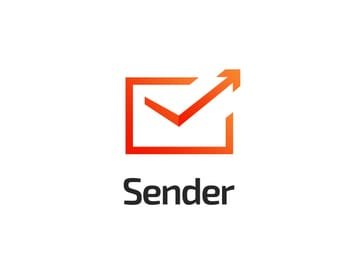Choosing the right email marketing tool is akin to finding a trusted partner in the vast digital landscape. It’s about discovering a platform that not only resonates with your marketing ethos but also empowers you to create meaningful connections with your audience. Today, we’re putting two noteworthy contenders under the spotlight: Sender and Sendloop. Both platforms offer a suite of features designed to enhance your email marketing efforts, but which one will best suit your needs? Let’s embark on a journey to uncover the nuances of each, beginning with a critical aspect that often decides the game: Ease of Use.
| Sender | Sendloop |
|---|---|
 |  |
| G2 Score – 4.4 out of 5 stars | G2 Score – 4.4 out of 5 stars |
| TrustRadius Score – 5.2 out of 10 | TrustRadius Score – Nil |
Ease of Use: Navigating the User Experience
The user experience of an email marketing tool can significantly influence your daily operations and overall strategy effectiveness. Here’s how Sender and Sendloop compare in terms of usability, from setting up campaigns to analyzing their performance.
Sender: Streamlining Your Marketing Efforts
Sender is renowned for its intuitive interface, designed to make email marketing as straightforward as possible. Right from the get-go, users are greeted with a clean, navigable dashboard that demystifies email marketing. Setting up a campaign in Sender is a hassle-free process, thanks to its user-friendly design and clear, step-by-step guidance.
The platform shines with its drag-and-drop email editor, enabling you to craft visually appealing emails without any prior design experience. Whether you’re looking to send a quick update to your subscribers or a detailed promotional campaign, Sender’s tools ensure that your emails not only look professional but also resonate with your audience. This focus on simplicity, without compromising on functionality, makes Sender an attractive choice for businesses seeking efficiency and effectiveness in their email marketing endeavors.
Sendloop: Customization at Your Fingertips
Sendloop offers a slightly different approach, emphasizing customization and flexibility. While it boasts a comprehensive set of features, the platform caters to users who prefer having more control over their email marketing campaigns. Sendloop’s interface is designed to accommodate both novice marketers and seasoned professionals, offering a range of customization options that can be tailored to suit your specific needs.
One of Sendloop’s standout features is its advanced segmentation and automation capabilities, allowing for highly targeted campaigns based on subscriber behavior and preferences. Although this level of customization is powerful, it may present a steeper learning curve for those new to email marketing. However, for users willing to explore Sendloop’s depth, the platform offers the potential to significantly enhance the personalization and effectiveness of your email marketing campaigns.
Choosing Your Path: Simplicity vs. Customization
When it comes to ease of use, your choice between Sender and Sendloop will largely depend on your preferences for simplicity versus customization. If you value a platform that allows you to quickly and easily create and send campaigns, with minimal learning required, Sender’s straightforward approach is likely to appeal to you. Its emphasis on an intuitive user experience ensures that you can focus on crafting messages that engage your audience, without getting bogged down by complexity.
On the other hand, if you’re seeking a platform that offers a higher degree of control and is rich in features for customizing your campaigns, Sendloop’s flexibility and advanced capabilities might be more your speed. While it might require a bit more time to master, the potential for creating highly personalized and targeted campaigns can be a game-changer for your email marketing strategy.
Both Sender and Sendloop offer compelling solutions for email marketing, but the best choice for you will depend on how you balance the trade-off between ease of use and the desire for deep customization and control.
Pricing and Plans: Balancing Affordability with Features
| Sender | Free Plan: Up to 2,500 subscribers and 15,000 emails per month. Includes basic features like newsletters and subscription forms. Standard Plan: Starting at $11/month for up to 5,000 subscribers and 60,000 emails. Includes advanced features like autoresponders and transactional emails. Professional Plan: Custom pricing based on higher volumes of subscribers and emails, including additional features like dedicated IP and webhooks. |
| Sendloop | Sendloop focuses on simplicity and ease of use in email marketing. Pay-As-You-Go Plan: Ideal for infrequent senders, with no monthly fees. You buy email credits as needed; for instance, 1,000 email credits cost approximately $10. Monthly Subscription Plans: Starting from around $9/month for up to 500 subscribers, with unlimited email sends. Pricing increases with the number of subscribers. |
Sender: Affordability Meets Versatility
Sender appeals to a wide range of businesses, especially small to medium-sized enterprises (SMEs), with its competitively priced plans. It distinguishes itself with a free plan that’s generous enough for businesses just dipping their toes into email marketing, providing essential features like automation, segmentation, and a respectable monthly email send limit. This allows companies to test the waters without initial investment.
As businesses grow and their email marketing needs become more sophisticated, Sender’s paid plans offer scalable solutions without a significant jump in cost. These plans increase sending limits and unlock additional features, providing great value for marketers looking to expand their reach and enhance their strategies. The transparency and simplicity of Sender’s pricing structure make it easy for businesses to predict their expenses as they scale, ensuring that they can plan their marketing budgets effectively.
Sendloop: Customized Solutions for Diverse Needs
Sendloop offers a slightly different approach to pricing, with plans designed to cater to a broad spectrum of users, from startups to large enterprises. Unlike Sender, Sendloop’s focus on customization and scalability is reflected in its pricing tiers, which are structured to accommodate the diverse needs of its user base. This means that businesses can choose a plan that closely matches their requirements, paying for the features they need without overspending on those they don’t.
Sendloop also provides options for high-volume senders and companies with specific needs, offering custom pricing plans upon request. This flexibility is a strong suit for Sendloop, catering to businesses that might find standard plans limiting. However, it’s worth noting that the entry point for Sendloop’s services may be higher than Sender’s, especially for businesses looking for advanced features right from the start.
Weighing Your Investment: Startup Friendliness vs. Custom Scalability
When comparing Sender and Sendloop on pricing and plans, the decision often comes down to your business’s current stage and growth trajectory. If you’re a startup or a small business seeking a cost-effective platform that offers a solid set of features out of the box, including a robust free plan, Sender provides a clear pathway for growth without hefty initial costs.
On the other hand, if you represent a larger business or your email marketing requirements are more complex, requiring a tailored approach, Sendloop’s customizable plans and the ability to scale in alignment with your specific needs offer the flexibility and scalability you might be looking for.
Both Sender and Sendloop present compelling options, but the best choice for you will depend on how you prioritize affordability, scalability, and the need for customized solutions in your email marketing strategy.
Automation and Workflow Capabilities: Streamlining Your Email Marketing
Sender: User-Friendly Automation for Every Marketer
Sender is designed with the aim of making email automation accessible and straightforward, even for those new to email marketing. The platform offers a robust set of automation tools that enable you to create automated email sequences based on specific triggers, such as subscriber actions or behavioral patterns. This could include welcome emails for new subscribers, follow-up messages based on engagement, or targeted offers based on past purchases.
The beauty of Sender’s automation features lies in their simplicity. With an intuitive interface and clear guidance, setting up automated workflows is a hassle-free process. This empowers businesses of all sizes to implement sophisticated email marketing strategies without the need for extensive technical knowledge or resources.
Sendloop: Advanced Automation for Precision Targeting
Sendloop takes a more granular approach to automation, offering advanced capabilities designed for marketers looking to execute highly targeted and personalized email campaigns. The platform allows for the creation of complex workflows that can be customized to an impressive degree, catering to a wide variety of scenarios and subscriber behaviors.
With Sendloop, you can dive deep into segmentation and conditional logic, tailoring your automated emails to match the specific needs and interests of different segments of your audience. This level of customization ensures that your messages are highly relevant and timely, increasing the likelihood of engagement and conversion. While powerful, Sendloop’s advanced automation features may come with a steeper learning curve, making them more suited to experienced marketers or those with specific, sophisticated automation needs.
Choosing the Right Automation Solution: Simplicity vs. Customization
When it comes to automation and workflow capabilities, your choice between Sender and Sendloop will largely depend on the complexity of your email marketing strategy and your comfort level with automation tools. If you’re looking for an easy-to-use platform that simplifies the automation process while still offering a range of effective marketing strategies, Sender’s user-friendly approach is likely to meet your needs.
On the other hand, if your marketing strategy demands highly customized and targeted automation workflows, and you’re comfortable navigating more complex tools, Sendloop’s advanced capabilities offer the precision and flexibility required to execute intricate email marketing campaigns.
Both Sender and Sendloop provide powerful solutions for automating your email marketing efforts, but the best fit for you will depend on how you balance the need for simplicity and user-friendliness against the desire for advanced customization and targeting capabilities.

Related: Check out our free SEO suite

Analytics and Reporting: Gaining Insights into Your Campaigns
Sender: Intuitive and Actionable Insights
Sender offers a comprehensive analytics dashboard that makes it easy for marketers to monitor the performance of their email campaigns. Key metrics such as open rates, click-through rates, unsubscribe rates, and conversions are clearly presented, allowing you to quickly gauge the success of your efforts. Sender goes beyond basic analytics by providing insights into subscriber behavior, including which links are clicked most frequently and how subscribers interact with your emails over time.
This data is invaluable for identifying what resonates with your audience, enabling you to tailor your content and strategy accordingly. Moreover, Sender’s reporting tools are designed to be accessible, ensuring that even those with minimal experience in data analysis can derive meaningful insights from their campaigns.
Sendloop: Detailed Reporting for Data-Driven Marketers
Sendloop provides advanced analytics and reporting features that cater to data-driven marketers looking to dive deep into the performance of their email campaigns. The platform offers detailed metrics on every aspect of your emails, from delivery rates to detailed engagement statistics. Sendloop’s strength lies in its ability to track subscriber actions in real-time, giving you a granular view of how individuals interact with your emails.
Additionally, Sendloop allows for A/B testing of email campaigns, enabling you to compare different versions of your emails to determine which elements lead to higher engagement. This focus on detailed analytics and testing makes Sendloop an excellent choice for marketers who rely on data to guide their decision-making and strategy refinement.
Deciphering Your Data: Accessibility vs. Depth
When comparing Sender and Sendloop on analytics and reporting, the decision between them hinges on your need for accessible insights versus in-depth data analysis. If you prefer a straightforward approach that offers clear, actionable insights into your email campaigns, Sender’s intuitive analytics dashboard provides the essential information you need to optimize your efforts without overwhelming complexity.
Conversely, if you’re a marketer who thrives on detailed data analysis and values the ability to conduct thorough A/B testing to refine your campaigns, Sendloop’s advanced reporting features offer the depth and granularity required to make informed, data-driven decisions.
Both Sender and Sendloop equip you with the tools to understand and improve your email marketing performance, but the best fit for you will depend on how you balance the simplicity of data interpretation against the desire for comprehensive analytics and testing capabilities.
List Management and Segmentation: Crafting Targeted Campaigns
Sender: Simplifying Subscriber Engagement
Sender excels in providing a seamless experience for managing your subscriber lists. The platform allows for easy importation, organization, and management of contacts, ensuring that your database is always up-to-date and efficiently segmented. This is crucial for sending personalized content that resonates with different segments of your audience.
Segmentation in Sender is intuitive, enabling you to create segments based on a variety of criteria, including subscriber behavior, engagement levels, and custom attributes. This flexibility ensures that your emails are as relevant as possible, increasing the likelihood of engagement and conversion. The platform’s focus on making list management and segmentation accessible means that businesses of all sizes can implement sophisticated email marketing strategies with minimal effort.
Sendloop: Advanced Segmentation for Precision Targeting
Sendloop offers robust tools for list management and segmentation, designed for marketers looking to execute highly targeted email campaigns. The platform supports detailed segmentation capabilities, allowing you to divide your subscriber list based on intricate criteria, from demographic data to specific interactions with your emails.
This advanced segmentation is particularly beneficial for creating personalized email campaigns tailored to the precise needs and interests of different audience segments. Sendloop’s approach to list management also includes features for maintaining list health, such as automatic removal of inactive subscribers and bounce management, ensuring your marketing efforts are focused on engaged contacts.
Tailoring Your Approach: Ease of Use vs. Detailed Customization
When comparing Sender and Sendloop on list management and segmentation, the choice between them will depend on the level of complexity you need in segmenting your audience and managing your lists. If you’re looking for an easy-to-use platform that simplifies the process of creating and managing segments, ensuring you can quickly tailor your campaigns to different audience groups, Sender’s straightforward tools are likely to appeal to you.
On the other hand, if your email marketing strategy requires detailed and complex segmentation to deliver highly customized content, Sendloop’s advanced segmentation features provide the granularity needed to precisely target your communications. This makes Sendloop a suitable option for marketers who prioritize precision targeting over simplicity.
Both Sender and Sendloop offer powerful solutions for managing your subscriber lists and creating targeted segments, but the best fit for your business will depend on how you prioritize ease of use against the need for detailed segmentation capabilities.
Integration Capabilities: Connecting Your Marketing Stack
Sender: Streamlined Integration for Efficiency
Sender recognizes the importance of integrating with the broader digital marketing ecosystem and offers straightforward options to ensure you can easily connect your email marketing efforts with other key tools in your marketing stack. Notable integrations include popular e-commerce platforms like Shopify and WooCommerce, which enable direct connections to your online store, allowing for more personalized marketing efforts based on customer behavior and purchase history.
Additionally, Sender’s integration with Zapier opens up a world of possibilities, allowing for connections with over 1,000 other apps and services. This means that even if a direct integration isn’t natively supported, you can likely still automate workflows between Sender and other tools you’re using, from CRM systems to social media platforms, enhancing the overall efficiency of your marketing operations.
Sendloop: Customizable Integrations for Advanced Users
Sendloop offers a different approach, focusing on providing customizable integration options that cater to advanced users and specific business needs. While it supports direct integrations with essential services, including some CRM platforms and analytics tools, Sendloop shines with its API access, allowing businesses with development resources to create custom integrations tailored to their unique workflows.
This level of customization is particularly valuable for businesses that require specific data exchanges between their email marketing platform and other parts of their tech stack, such as proprietary systems or specialized software. However, leveraging these custom integrations typically requires a higher degree of technical expertise, making it a more suitable option for organizations with access to development resources.
Bridging Your Marketing Tools: Simplicity vs. Customization
Deciding between Sender and Sendloop based on integration capabilities often comes down to the balance between needing straightforward, ready-made connections and requiring the ability to customize integrations for complex workflows. Sender offers an accessible solution with its Zapier integration, making it suitable for businesses looking for a broad range of connection possibilities without the need for custom development.
Conversely, Sendloop’s emphasis on customizable integrations via API access provides a flexible solution for businesses with specific integration needs, assuming they have the technical know-how or resources to develop these connections. This makes Sendloop an attractive option for larger organizations or those with unique system requirements.
Both Sender and Sendloop enable you to extend the functionality of your email marketing efforts through integrations, but the right choice for your business will depend on the complexity of your integration needs and the resources you have available for customization.
Conclusion
Choosing between Sender and Sendloop for your email marketing tool boils down to aligning the platform’s capabilities with your business’s specific needs. Sender shines with its user-friendly interface, making it ideal for small to medium businesses seeking simplicity and efficiency in their email marketing efforts. Its straightforward integrations and generous free plan offer a solid foundation for those looking to start or scale their email campaigns without complexity.
On the other hand, Sendloop appeals to businesses requiring a more tailored approach, with its customizable integrations and advanced segmentation capabilities standing out for companies with specific needs or those with the resources to leverage its API for bespoke solutions. Ultimately, whether you lean towards Sender for its ease of use and accessible features or Sendloop for its flexibility and depth, both platforms offer unique strengths to support your email marketing strategy and help you connect effectively with your audience.
Read Next:
- Keyword Trends: Tracking Seasonal and Evergreen Keywords
- Keyword Difficulty: Evaluating Keyword Competitiveness
- Keyword Intent: Understanding User Search Intent for Startup
- How to Identify High-Volume Keywords for Startup Visibility
- Using Google Keyword Planner for Startup Keyword Research






















Comments are closed.